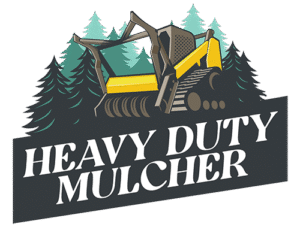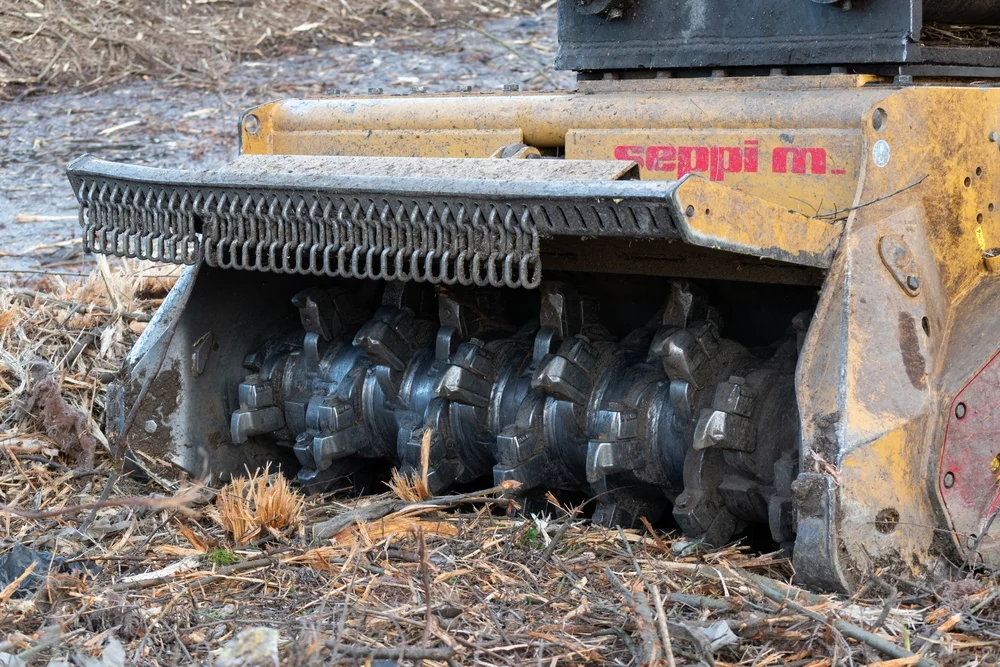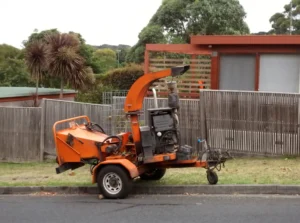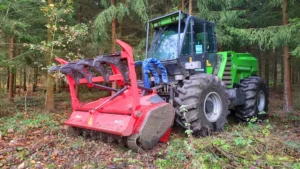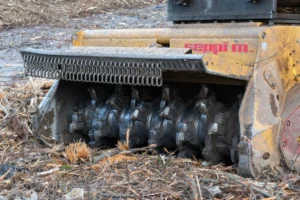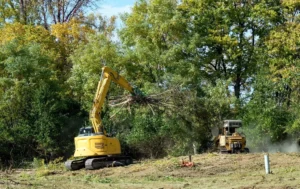Durability is not luck, it is design. In the field, mulchers grind through shock loads, dust, heat, and constant vibration. The machines that keep cutting, day after day, share the same core traits, strong structures, balanced hydraulics, cool running systems, protected bearings, and service points that crews can reach in minutes.
This guide breaks down those traits so you can judge a unit in the yard or on a demo, then run it with a method that protects the investment.
Use it with the practical routines in the operator guides and the maintenance checklists to keep performance steady through long weather windows.
Frame, materials, and structural design
A durable mulcher starts with the frame. High yield steel in the right places resists twist, abrasion resistant plate where chips and rocks strike keeps shells from thinning, and gussets that follow the load path stop cracks before they begin.
Look for replaceable wear shoes and liners where grit builds, and for stitch patterns that spread stress rather than concentrate it at hard corners.
Structures should protect hoses, case drains, and electrical runs without blocking airflow or access. When the frame is right, the machine feels tight on slopes and the head stays centered under load, which shows up as cleaner chips and lower temperatures.
Steel selection and wear surfaces
Material choice decides how the machine ages. The shell around the rotor takes constant abrasion, the mounts transfer shock, and the skid points live in dirt and rock.
Good builders separate those jobs with the right steel and with parts you can replace without stripping the whole head. Surfaces that soak abrasive spray get liners, edges that meet the ground get bolted shoes, and the main frame stays a strong, simple core you rarely touch.
That design makes field repairs faster and cheaper, and it keeps the structure true through years of work.
What to check on the ground
- Look for abrasion resistant liners and bolt on skid shoes at the lowest wear zones
- Confirm high yield plate in mounts and arms, with no thin patches at stress points
- Check that hose guards and belly pans protect without trapping wet debris
- Verify that wear parts can be replaced without pulling the whole head apart
- Inspect paint and seal quality at seams where moisture could creep in
If you can point to the parts that will take the beating, and you can remove them with basic tools, you are looking at a head that will stay square and serviceable for the long run.
Welds, gussets, and load paths
Strong steel needs smart welds. Continuous welds near hot corners can pull the frame, skip welds in the wrong spot can leave cracks room to grow. Gussets should land where forces meet, not where they just look tidy. Mount ears want generous radius cuts, not sharp inside corners. On the carrier, track frames and boom mounts should show clean beads and consistent penetration, with no drilled holes through protected members.
Inspection spots that tell the truth
- Inside corners of mount ears and boom plates for start stop marks or undercut
- Gusset ends for abrupt terminations that point straight into thin plate
- Welds near gearboxes and bearing housings for hairline cracks or rust trails
- Underside of the shell where rocks ricochet and paint wears first
- Track frame cross members and idler mounts for signs of flex or elongation
Clean welds and thoughtful gussets are more than looks, they are insurance against downtime when the head meets a stubborn stump or a hidden rock.
Shock management and rotor protection
Durability also lives in the parts you do not see working. Shear bolts, relief valves, belt drives, and clutches are fuses that absorb shock before it reaches the expensive bits.
A head that pairs the right fuse with a stiff rotor survives contact then returns to balance without drama.
Add guards that stop wire and fence from walking into seals, and you protect bearings that would otherwise suffer from one bad moment.
Features that extend bearing life
- Belt drive or torque limiter between rotor and motor to absorb spikes
- Shear points sized to fail cleanly and replace in minutes, not hours
- Seal guards and rope cutters at bearing faces to stop wire and vines
- Case drain monitoring and easy access to check flow and temperature
- Sight lines and ports that let you spin and inspect the rotor safely
When a design treats shock like a fact, not a surprise, crews spend less time recovering and more time cutting. For slope and firebreak work, see the method notes in fire prevention and firebreaks.
Hydraulics and cooling built for continuous duty

A mulcher lives or dies by its oil, so systems that balance flow and pressure, that move a lot of air across clean coolers, and that keep contamination out will run cooler and last longer. Matching the head to the carrier is the first step, and understanding the differences in drive systems helps you judge how each architecture handles heat and torque. In the yard, warm the unit and read pressure at the test ports, then watch response under light load, since the head should reach speed smoothly and hold it while you feed a modest bite. Make these readings part of your daily rhythm with brief pre operation checks, because early corrections prevent long hot afternoons later.
Pump and motor sizing, flow and pressure balance
Matching the head to the carrier is step one in durability. Too little flow and you chase production with aggressive feed that overheats oil, too much pressure without relief and you eat mounts and belts.
Builders who publish real numbers and give you access to verify them are doing you a favor. In the yard, warm the unit and read pressure at the test ports, then watch response under light load. The head should reach speed smoothly and hold it while you feed a modest bite.
Signs of a healthy hydraulic pair
- Published flow and pressure that match the head requirement, verified at temperature
- Smooth run up without chatter or surge, steady speed while feeding brush
- Relief valves you can reach and set, with clear documentation
- Clean case drain routing with no heat scuff, and a simple way to check flow
- Quiet hoses and mounts, no audible whine that hints at cavitation
Balanced systems reduce heat, cut fuel burn, and protect seals.
Cooling pack layout and debris management
Mulching throws fine fibers that glue themselves to anything warm. Cooling packs that face clean air, with screens you can lift and blow out in minutes, keep temperatures in range.
Reversible fans help, but only if air has a clear path and screens seal properly so dust does not bypass the core. Heat shields around manifolds and belts deserve the same attention so debris never cooks where it lands.
Cooling details that matter
- Screens that hinge or slide without tools, with seals that actually seal
- Reversible fan with a manual override and a cycle you can adjust for dust days
- Straight ducting and no sharp turns that trap debris behind the core
- Clear space to work a blower safely, and a cleanout schedule in the plan
- Temperature readings easy to see in the cab, not buried in a menu
Machines that breathe well run longer days. Pair the hardware with the cleanout rhythm in the maintenance checklists and you will feel the difference in a week.
Filtration and contamination control
Clean oil is the simplest durability boost you can buy. Return and charge filtration protect pumps and motors, breathers keep moisture out during cool downs, and magnetic plugs catch the fines you cannot see.
Sample ports let you pull oil for analysis, which is how you fix problems before they become failures. Good routing keeps hoses from rubbing, and clamps stop lines from vibrating into leaks.
Controls that keep oil clean
- Return and charge filters with indicators you can read at a glance
- Quality breathers on tanks, not open caps that drink dust overnight
- Magnetic drain plugs in gearboxes and tanks, checked on every service
- Sample ports at sensible heights so pulls are safe and fast
- Hose clamps and abrasion sleeves at every potential rub point
Oil that stays clean keeps pumps and motors honest. Tie filter dates and samples to your log in long term care and you will extend service intervals with confidence.
Cutting head and bearing durability
A durable head carries a straight, stiff rotor on protected bearings, holds teeth securely at the correct angle, and controls discharge so chips go down rather than out.
Doors, curtains, and deflectors are not an afterthought, they control throw, protect the public, and shape chip flow so the head does not snowplow, and they should latch and cover reliably while sightlines stay open.
Align daily walkarounds with OSHA and ANSI mulcher safety standards so checks are consistent across crews, because controlled discharge is a safety win and a durability win, chips that go down do not blast seals or glass, and the finish you leave is easier to sign off near sensitive boundaries.
Rotor, bearings, and seals
Rotors should be straight, balanced, and guarded at the ends. Bearing housings need protection from strikes and from the stringy debris that wants to walk into seals. Grease points must be reachable with the head grounded and locked out, and torque values for end caps and mounts should be clear and realistic for field tools.
What shows a long lived head
- Bearing guards with rope cutters and seal protectors at both ends
- Rotor that spins down smoothly with no wobble or scrape
- End cap fasteners you can torque with tools you carry
- Clear lockout points so inspections happen with zero energy
- Space to clean around housings so heat never bakes packed chips
Protected bearings are the quiet heart of durability. When they stay cool and clean, everything else gets easier.
Tooth system and retention hardware
Teeth do the cutting and take the hits. A system that locks hard, resists spin, and swaps quickly keeps operators focused on the cut.
Carbide for dirty and rocky work, sharp steel for clean wood and fine finish, both with hardware that you can torque consistently with a standard tool.
If the design lets you rotate positions to even out wear, you save money and vibration.
Tooth choices that pay back
- Positive lock geometry that resists spin and keeps angle correct
- Hardware that matches a common torque tool and a spare kit on the truck
- Options for carbide and steel to match stand and finish goals
- Clear numbering or pattern marks so rotations are simple to track
- Wear indicators that help new operators learn when to swap
Teeth that stay put and swap clean keep the rotor balanced and the oil cool. Use the wear log pattern in maintenance checklists to make rotations automatic.
Guarding and discharge control
Guarding is not an afterthought. Doors, curtains, and deflectors control throw, protect the public, and shape chip flow so the head does not snowplow.
Guards must latch, curtains must cover, and sightlines must stay open.
Designs that hold chips down reduce risk near traffic and make it easier to meet buffer rules along water and habitat.
Guarding features to insist on
- Front door that feeds smoothly and latches positively every time
- Chain curtains or equivalent shields with no gaps at the opening
- Side deflectors that are stiff enough to keep shape under load
- Sightlines that stay clear with guards fitted, wipers and lights that help
- Simple checks you can do daily to confirm everything still protects
Controlled discharge is a safety win and a durability win. Chips that go down do not blast seals or glass, and they leave a finish you can sign off near roads and rails, see roadside and railway clearing.
Service ability that keeps machines alive
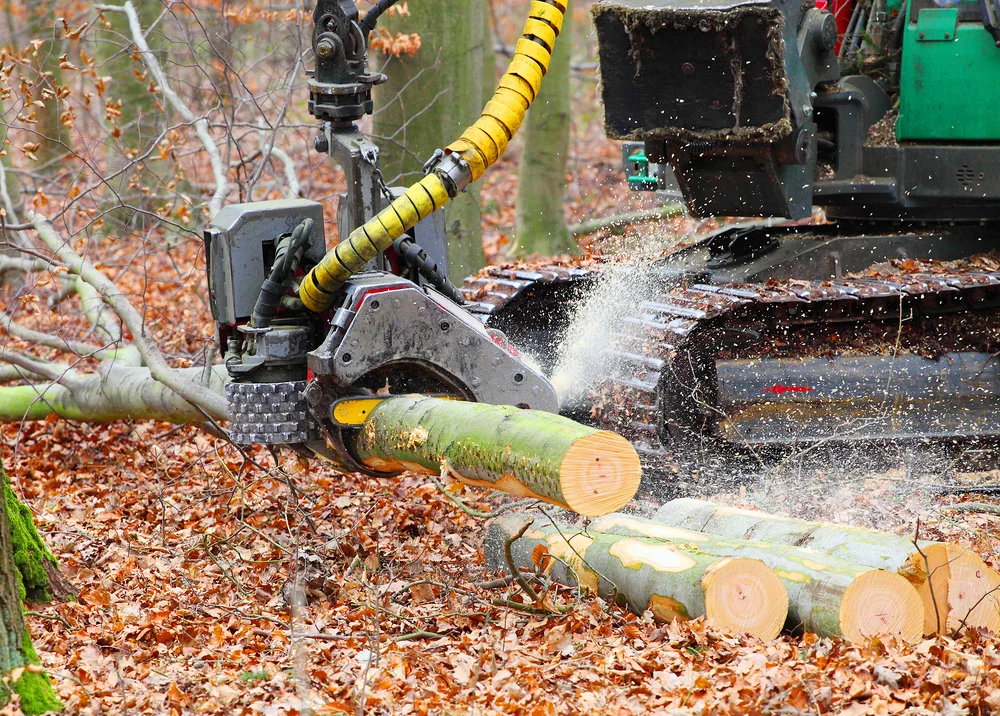
Durability depends on what crews can reach and reset in minutes. Smart layouts turn service into habit, not a chore people skip when days run long.
Access, fasteners, and common service points
Good machines welcome a wrench. Screens hinge, covers lift without a second person, and common fasteners match tools already on the truck. Grease points sit where you can see them, and belts can be tensioned without stripping guards for half an hour.
If cleanout requires the same four bolts every time, those bolts should have captive hardware and real hand space.
Service design that saves hours
- Hinged screens and lids with stays, no hidden fasteners
- Grease points in line of sight with labels that match the manual
- Captive nuts and standard sizes so tools swap fast across tasks
- Belt tensioners reachable without removing unrelated guards
- Storage for the lockout pin and a tag station near the ignition
When service takes minutes, it gets done. That alone adds months to life.
Diagnostics and sensors that help operators
Simple diagnostics turn symptoms into fixes. Temperature and pressure views that update quickly, not buried graphs, help operators slow and clean before heat soars. Case drain flow checks tell you when a motor is drifting. A clean fault log helps techs find intermittent issues without guesswork. Cameras and lights solve visibility when dust and low sun fight the cab.
Small assists that change the day
- Clear gauges for hydraulic and engine temperature in the cab
- Easy access pressure and case drain ports with caps that seal
- Fault codes that describe real conditions, not mystery numbers
- Work lights and cameras that stay clean and are easy to wipe
- A simple place to write down readings during the pre start brief
Give operators information they can act on and they will protect the machine for you.
Documentation and parts support
Even the best machine needs parts and clear books. A real parts diagram, a manual with torque values and service intervals, and a support line that answers with more than a voicemail keep days moving.
Builders who stock common wear items and ship fast earn their reputation in the first breakdown you do not have.
Support that proves durability
- Parts diagrams with real callouts, not thumbnails
- Manuals that list torque, fluids, and intervals in one table
- Stock on the common wear items you know you will need
- Fast answers on setup and fault codes when the field calls
- Serial tracking for updates so your unit receives improvements
Durability is a relationship. Tools, parts, and people all count.
Field tests to judge durability in one afternoon
You can learn a lot in a short demo. Warm the unit, read temperatures and pressure, cut mixed material, and clean the coolers once.
Watch how quickly the head reaches speed, how chips fall, and how easy screens open.
Look at the paint after the cut where chips blasted, check the curtains and door, then torque one tooth and one guard bolt to feel the hardware.
Quick demo checklist
- Warm to operating temperature, record baseline temps and pressure
- Run light, then moderate feed, listen for bog, chatter, and belt slip
- Inspect chips and finish, then open screens and clean coolers once
- Check for hot spots, packed debris, and access to grease and fasteners
- Record post demo temps, compare to baseline for cooling performance
Bring that list, then pair what you saw with real routines in the operator guides, the maintenance checklists, and the storage notes in long term care. You will know if the machine will still feel tight in three seasons.
BLOCKQUOTE “Durability is not a spec on a page, it is a pattern of small design choices. If crews can reach it, clean it, and check it in minutes, that is a durable machine.”
— James Carter, Operations Director
Want a durability checklist you can use today
If you would like a one page durability checklist matched to your carrier and head, with inspection points and readings your crew can record in five minutes, tell us your machine, typical stand, and climate, and we will map it to your ground, then we will send you a ready to use sheet and talk through any special conditions.
Talk to an expert to receive help tailoring the routine to your fleet.
